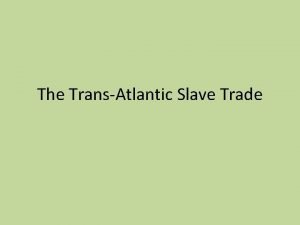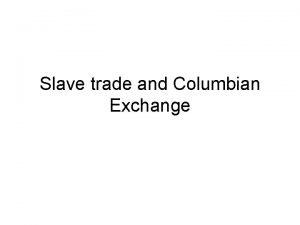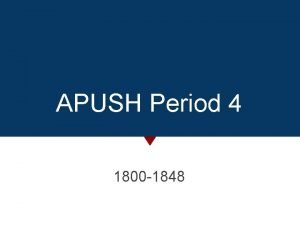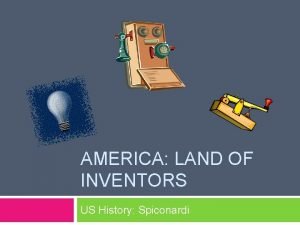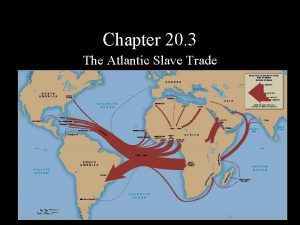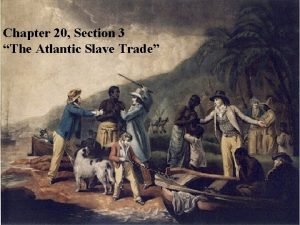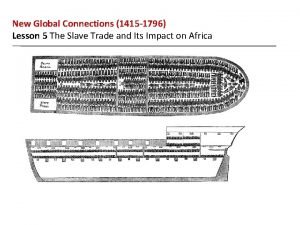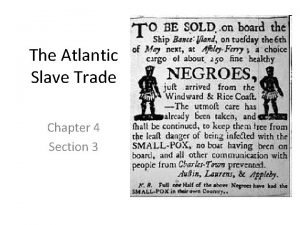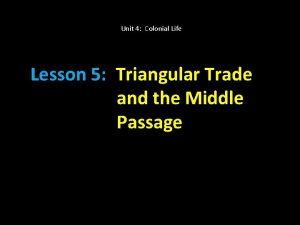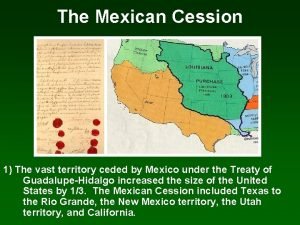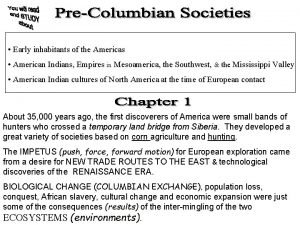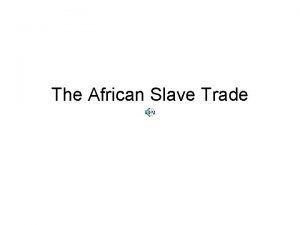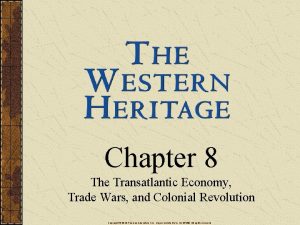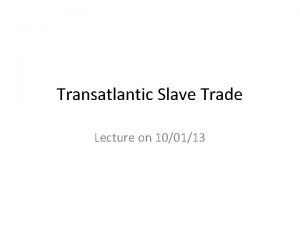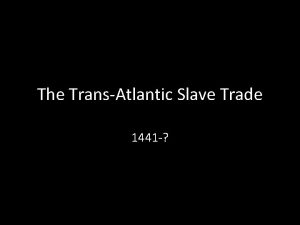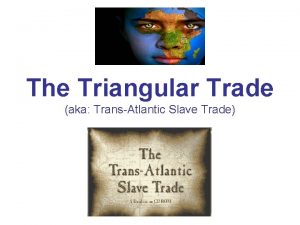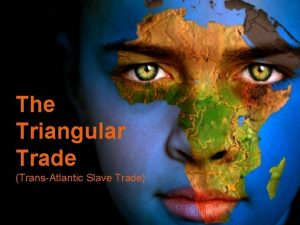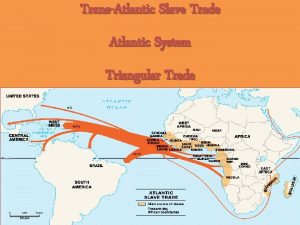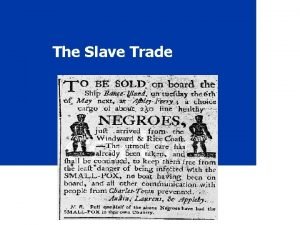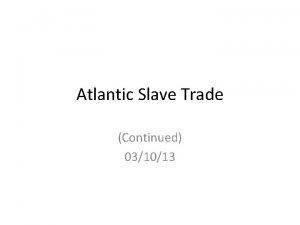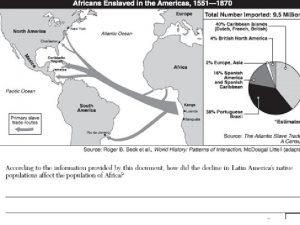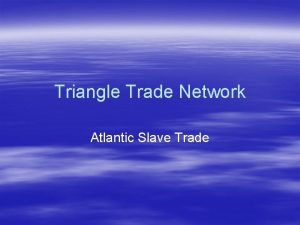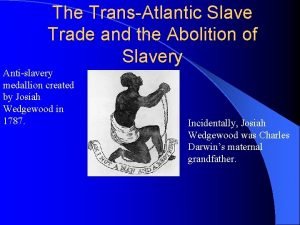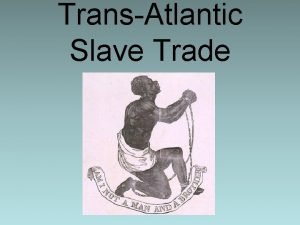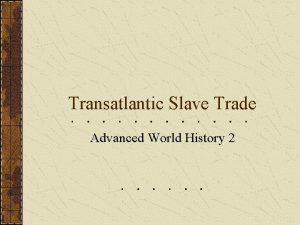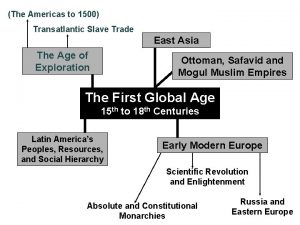Transatlantic Slave Trade APUSH Adapted from piccle ed



















- Slides: 19

Transatlantic Slave Trade APUSH Adapted from piccle. ed. psu. edu Advanced World History

Why was Africa vulnerable to the Slave Trade? Political Fragmentation Sailing Routes Availability of People (high birth rate) Civilizations and Skills (metalworking, farming, herding) No diplomatic repercussions.

Countries Participating Britain Denmark France Holland Portugal Spain Norway

Geography of Slavery Enslaved Africans mostly came from the area stretching from the Senegal River in Africa to Angola. Europeans divided the area into five regions: Upper Guinea Coast Ivory Coast Lower Guinea Coast Gabon Angola

How did slavery differ from indentured servitude? Indentured Servitude Slavery Contracted Time Period For life/freedom was not contractual. Could be bought, sold, or leased. Could be punished by whipping. Were allowed to own property. Not property owners.

Why Africa? Sailing Routes Lack of Familiarity with the Americas Availability of People Civilizations and Skills Metal Working Farming Hearding No diplomatic repercussions

Two main patterns of Triangular Trade Rum from New England to West Africa Slaves to sugar islands Molasses home to the New England distilleries Manufactured goods from England to Africa Goods exchanged for slaves taken to West Indies. Profits used to purchase sugar (and other goods) for England.

Middle Passage Origins of the Infamous Middle Passage The middle leg of a three part voyage. Began and ended in Europe. Carried cargo of iron, cloth, brandy, firearms, gunpowder Lnded on Africa’s Slave Coast and exchanged cargo for Africans Set sail for the Americas, where slaves were exchanged for sugar, tobacco, mlasses. Final brought the ship back to Europe.

Middle Passage 1600 - 1850’s The Capture Approx. 60 forts build along the west coast of Africa. Walked in slave caravans to the forts some 1000 miles away. Selected by the Europeans and branded. One half survived the death march. Place in underground dungeons until they were boarded on ships.

Middle Passage Statistics 10 -16 million Africans forcibly transported across the Atlantic from 1500 -1900. 2 million died during the Middle Passage (10 -15%) Another 15 -30% dies during the march to the coast. For every 100 slaves that reached the New World, another 40 died in Africa or during the Middle Passage.

Middle Passage Conditions on Board the Ship Slaves chained together and crammed into spaces sometimes less than five feet high. Slavers packed three of four hundred Africans into the ship cargo holds. Little ventilation, human waste, horrific odors. Unclean.

British Slave Ship

Middle Passage Tight packing - belly to back, chained in twos, wrist to ankle (660+), naked. Loose packing - shoulder to shoulder chained wrist to wrist or ankle to ankle. Men and woman separated (men placed towards bow, women toward stern). Fed once of twice a day and brought on deck for limited times.

Middle Passage Journey lasted 6 -8 weeks. Due to high mortality rate, cargo was insured (reimbursed for drowning accidents but not for deaths from disease of sickness) Common to dump your cargo for sickness or food shortages. Slave mutinies on board ships were common (1 out of every 10 voyages across the Atlantic experience a revolt). Covert resistance (attempted suicide, jumped overboard, refusal to eat).

Deck for a limited time “Dance the Slave” for excercise

Destination of Captives Caribbean 40% Brazil 40% Latin America 10% British North America 10%

Slave Resistance: Passive and Active Resistance Breaking tools Faking illness Staging slowdowns Committing acts of arson and sabotage Running Away

Slave Revolts Stono River- South Carolina Slaves tried to escape to Spanish Florida

Legacy of Slavery Agriculture Rice Sweet Potatoes Herding Basketry Working Style (cooperative labor) Planting (heel to toe) Food Spices (red pepper, sesame, cajun) Okra, black eyed peas Rice Dishes Gumbo, jambalaya Ash and hot cakes Sweet potato pie Music Banjo Drum Blues/Jazz Call and response Spirituals Religion Call and response patterns Emotional services Multiple spirits and souls Voodoo Tales and Words Trickster takes (Anansi the Spider, Brer Rabbit, Bugs Bunny) Words like bogus, bug, phony, yam, tote, gumbo, tater, jamboree, jazz. Creole Language
 Triangular trade video
Triangular trade video Triangular trade apush
Triangular trade apush Transatlantic slave trade pictures
Transatlantic slave trade pictures The transatlantic slave trade
The transatlantic slave trade Transatlantic slave trade
Transatlantic slave trade Transatlantic telegraph cable apush
Transatlantic telegraph cable apush Transatlantic telegraph cable apush
Transatlantic telegraph cable apush The atlantic slave trade chapter 20 section 3
The atlantic slave trade chapter 20 section 3 The age of exploration outcome the atlantic slave trade
The age of exploration outcome the atlantic slave trade Chapter 20 section 3 the atlantic slave trade
Chapter 20 section 3 the atlantic slave trade Lesson 5 the slave trade and its impact on africa
Lesson 5 the slave trade and its impact on africa Chapter 4 section 3 the atlantic slave trade
Chapter 4 section 3 the atlantic slave trade Destination america
Destination america Slave trade primary sources
Slave trade primary sources Washington dc slave trade
Washington dc slave trade Effects of the slave trade on africa
Effects of the slave trade on africa The age of exploration outcome the atlantic slave trade
The age of exploration outcome the atlantic slave trade Atlantic slave trade
Atlantic slave trade Transatlantic slaves
Transatlantic slaves Transatlantic tunnel
Transatlantic tunnel


